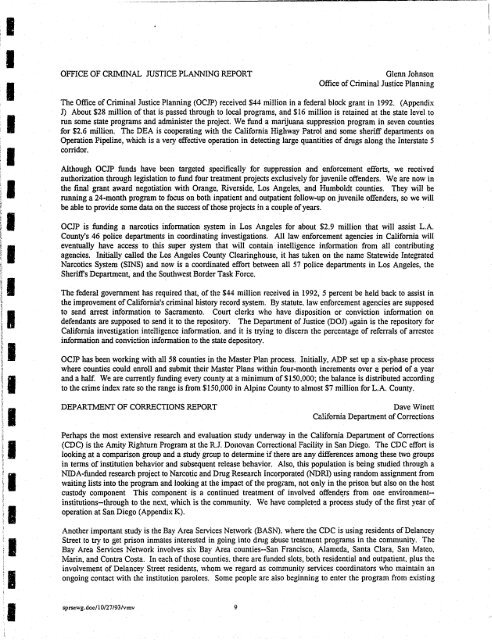1 - National Criminal Justice Reference Service
1 - National Criminal Justice Reference Service
1 - National Criminal Justice Reference Service
You also want an ePaper? Increase the reach of your titles
YUMPU automatically turns print PDFs into web optimized ePapers that Google loves.
I<br />
I<br />
I<br />
I<br />
I<br />
I<br />
I<br />
I<br />
I<br />
I<br />
I<br />
I<br />
I<br />
I<br />
I<br />
I<br />
I<br />
I<br />
OFFICE OF CRIMINAL JUSTICE PLANNING REPORT<br />
Glenn Johnson<br />
Office of <strong>Criminal</strong> <strong>Justice</strong> Planning<br />
The Office of <strong>Criminal</strong> <strong>Justice</strong> Planning (OCJP) received $44 million in a federal block grant in 1992. (Appendix<br />
]) About $28 miIIion of that is passed through to local programs, and $16 million is retained at the state level to<br />
run some state programs and administer the project. We fund a marijuana suppression program in seven counties<br />
for $2.6 millicm. The DEA is cooperating with the California Highway Patrol and some sheriff departments on<br />
Operation Pipeline, which is a very effective operation in detecting large quantities of drugs along the Interstate 5<br />
corridor.<br />
Although OCJP funds have been targeted specifically for suppression and enforcement efforts, we received<br />
authorization through legislation to fund four treatment projects exclusively for juvenile offenders. We are now in<br />
the final grant award negotiation with Orange, Riverside, Los Angeles, and Humboldt counties. They will be<br />
running a 24·month program to focus on both inpatient and outpatient fo!low.up on juvenile offenders, so we will<br />
be able to provide some data on the success of those projects !n a couple of years.<br />
OCJP is funding a narcotics information system in Los Angeles for about $2.9 million that will assist L.A.<br />
County's 46 police departments in coordinating investigations. All law enforcement agencies in California will<br />
eventually have access to this super system that will contain intelligence infOimation from all contributing<br />
agencies. Initially called the Los Angeles County Clearinghouse, it has taken on the name Statewide Integrated<br />
Narcotics System (SINS) and now is a coordinated effort between all 57 police departments in Los Angeles, the<br />
Sheri.ff's Department, and the Southwest Border Task Force.<br />
The federal government has required that, of the $44 million received in 1992, 5 percent be held back to assist in<br />
the improvement of California's criminal history record system. By statute. law enforcement agencies are supposed<br />
to send arrest information to Sacramento. Court clerks who have disposition or conviction information on<br />
defendants are supposed to send it to the repository. The Department of <strong>Justice</strong> (DO]) again is the repository for<br />
California investigation inte1ligence information. and it is trying to discern the percentage of referrals of arrestee<br />
information and conviction information to the state depository.<br />
OCJP has been working with all 58 counties in the Master Plan process. Initially, ADP set up a six·phase process<br />
where counties could enroll and submit their Master Plans within four·month increments over 2 period of a year<br />
and a half. We are currently funding every county at a minimum of $150.000; the balance is distributed according<br />
to the Clime index rate so the range is from $150,000 in Alpine County to almost $7 million for L.A. County.<br />
DEPARTMENT OF CORRECTIONS REPORT<br />
Dave Winett<br />
CzJifornia Department of Corrections<br />
Perhaps the most extensive research and evaluation study underway in the California Department of Corrections<br />
(CDC) is the Amity Righturn Program at the R.I. Donovan Correctional Facility in San Diego. The CDC effort is<br />
looking at a comparison group and a study group to determine -if there are any differences among these two groups<br />
in terms of institution behavior and subsequent release behavior. Also, this population is being studied through a<br />
NIDA·funded research project to Narcotic and Drug Research Incorporated (NDRI) using random assignment from<br />
waiting lists into the program and looking at the impact of the program, not only in the prison but also on the host<br />
custody component This component is a continued treatment of involved offendt;;rs from one environment··<br />
institutions-through to the ne:-.1, which is the community. We have completp.d a process study of the first year of<br />
operation at San Diego (Appendix K).<br />
Another important study is the Bay Area <strong>Service</strong>s Network (BASN). where the CDC is using residents of Delancey<br />
Street to try to get prison inmates interested in going into drug abuse treatment programs in the community. The<br />
Bay Area <strong>Service</strong>s Network involves six Bay Area counties-·San Francisco, Alameda, Santa Clara, San Mateo,<br />
Marin, and Contra Costa. In each of those counties. there are funded slots, both residential and outpatient. plus the<br />
involvement of Delancey Street residents. whom we regard as community services coordinators who maintain an<br />
ongoing contact with the institution parolees. Some people are also beginning to enter the program from existing<br />
sprsewg.doc/l0l27/93/vmv 9
















